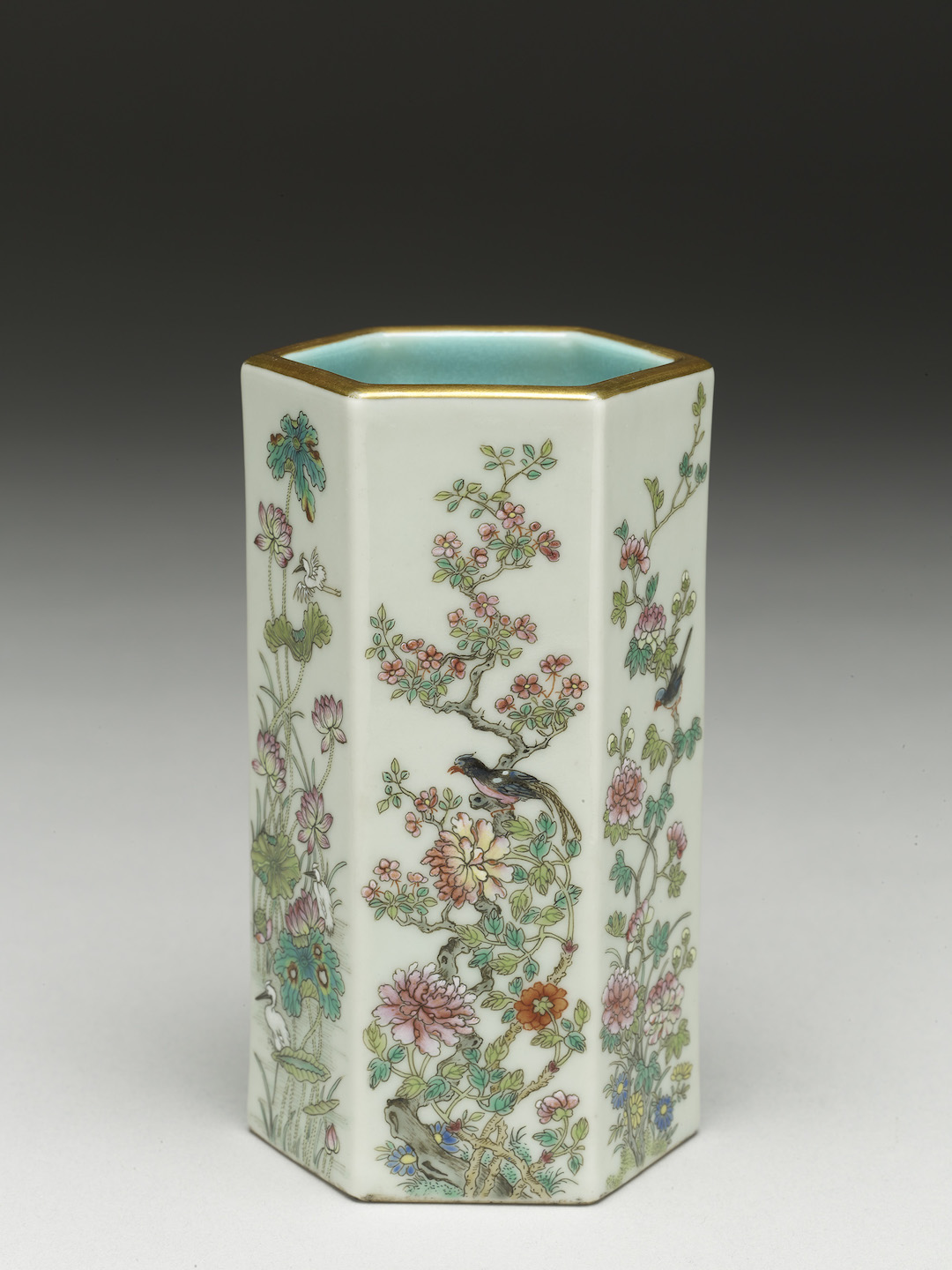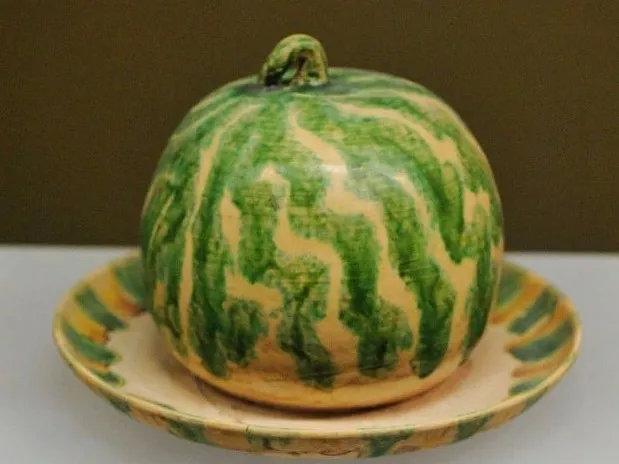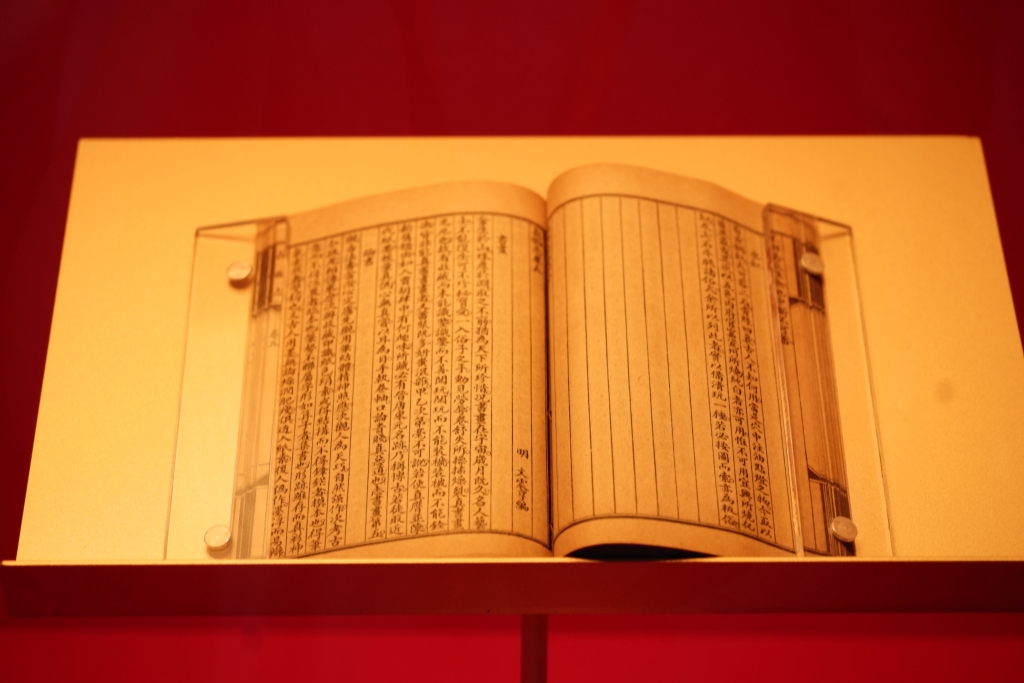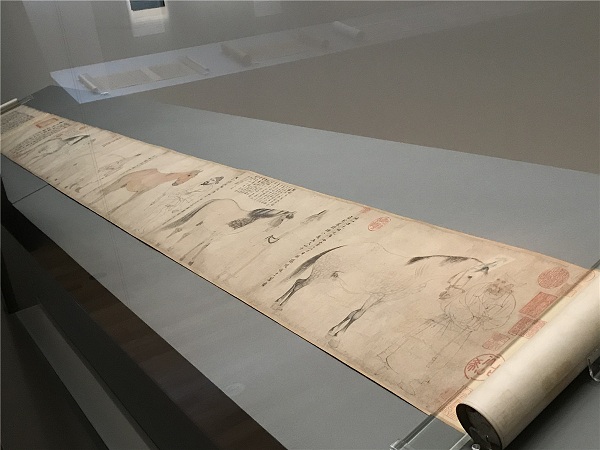
What was the scene like in the capital of the Qing Dynasty during the Lantern Festival? According to Pan Rongsheng's "Annals of the Capital" in the Qing Dynasty, to celebrate the Lantern Festival, "the whole city was lit up with lanterns from the 13th to the 16th night, and the guards did not stop it." There was no curfew in the capital, lanterns were hung everywhere, and there were various performances. In the "Seasonal Celebrations: Festival Artifacts from the Museum's Collection" currently on display at the National Palace Museum in Taipei, there is a pair of "Enamel Bowls with Lanterns and Peace", which depict the scene of the Lantern Festival.
The Paper learned that this exhibition uses ancient Chinese seasonal artifacts from the National Palace Museum in Taipei to reveal the life and scenery of the four seasons in the Qing Dynasty through different festival activities from three units: "Seasonal Sequences", "Three Festivals Celebrating the Same Time", and "Four Seasons in Harmony".
In order to cope with and adapt to the cyclical changes in the environment, the ancients summarized their observations of climate and phenology and their experiences in daily life, and developed a concept of carrying out specific activities at specific times. They also summarized the time concept of using one year, four seasons, eight festivals, twelve months, twenty-four solar terms, and seventy-two solar terms to record time, and thus developed various corresponding behaviors and festival cultures based on the calendar and seasons.
The Qing Dynasty was a regime established by the grassland peoples. Before entering the Central Plains, it had come into contact with the rules and regulations of the Ming Dynasty. After entering the Central Plains, it mostly followed the traditional seasons and festivals of the Han people, and also followed a set of time concepts that determined work and rest and arranged farming work based on the movement of celestial phenomena and seasonal changes. On the other hand, in seasonal activities and festival culture, the original customs and habits of Manchu and Mongolian can be seen everywhere, reflecting the coexistence of multiple ethnic cultures.
Yearly sequence
In response to and adapting to changes in the environment and phenology, the Manchu Qing Dynasty carried out its actions in a chronological order that both followed Han customs and maintained Manchu-Mongolian traditions. It also conveyed its concept of time through poetry, calligraphy and painting, with flowers, birds and seasonal activities that responded to the seasons and phenology, making the time of the Qing Dynasty have different appearances in the understanding of the four seasons, twelve months, twenty-four solar terms and seventy-two solar terms.

Hexagonal Powder-Rosy Flower and Bird Pattern Brush Holder, Jiaqing Period, Qing Dynasty
This pink-green hexagonal brush holder is decorated with flowers on all sides, showing the changing seasons of nature. Peonies, peonies and roses represent spring, lotus flowers represent summer, chrysanthemums represent autumn, and white plum blossoms represent winter. It is also decorated with various birds such as ribbons and herons. On the bottom there are six seal characters written in red: "Made in the Jiaqing Period of the Qing Dynasty".

Volume 5 of the Records of Superfluous Things, written by Ming Wen Zhenheng during the reign of Emperor Qianlong of the Qing Dynasty, and compiled in the Wenyuan Pavilion of the Complete Library in Four Treasures

Volume 5 of the Records of Superfluous Things, written by Ming Wen Zhenheng during the reign of Emperor Qianlong of the Qing Dynasty, and compiled in the Wenyuan Pavilion of the Complete Library in Four Treasures
In the early seventeenth century, Wen Zhenheng (1585-1645) borrowed the allusion of "having no valuable possessions" from A New Account of Tales of the World and compiled his knowledge of music, chess, calligraphy, painting, food, clothing, utensils, and landscaping into Records of Superfluous Things. Among them, the "Monthly Hanging Paintings" use the contents of the paintings decorated at home to express the corresponding scenery, insects or seasonal activities of each month.
Three festivals celebrated together
Festivals reflect traditional wisdom and the interest in life. "Draft History of Qing Dynasty·Rituals Volume 7" records: In the eighth year of Shunzhi (1651), New Year's Day, Winter Solstice and Longevity Festival were designated as the three major festivals; following the changing time sequence of historical cycles and natural cycles, the annual New Year's Day court meeting, Winter Solstice worship of heaven and Longevity Festival showed the Qing Dynasty's response to changes in the human, time, and geographical environment, as well as the interaction between man and nature passed down from generation to generation.
winter solstice

Qing Dynasty Gilded Bronze and Turquoise Fasting Plaque
The Winter Solstice Circular Mound Heaven Sacrifice was one of the most solemn ceremonies in the Qing Dynasty, and was performed by the emperor himself. In order to be sincere and have a righteous heart, one must fast before offering sacrifices. During the fasting period, the emperor and his accompanying ministers wore fasting badges on their chests to alert their bodies and minds and show their sincere respect.
This "Gold-plated Copper and Turquoise Fasting Plate" is made of filigree with the Chinese characters "fasting" in lapis lazuli on the front and back, surrounded by turquoise dark Eight Immortals patterns, and bat-shaped coral beads and pearls strung together with ribbons above and below.

Nine Yangs to Eliminate Cold - Dong Bangda of the Qing Dynasty
According to Zhuo Zhong Zhi, during the winter solstice, the Imperial Household Department of the Ming Dynasty printed "Zhao Han Tu" woodcuts for use in the palace. The Nine Yangs to Dispel the Cold was created by Emperor Qianlong, who ordered the poet and painter Dong Bangda (1699-1769) to imitate the old Qing palace paintings to dispel the cold. The painting depicts a zigzag-shaped winding river that runs through the foreground and background from a bird's-eye view. There is a poem for each scene on the shore. The nine poems celebrate the change of seasons from winter to spring, and there is also an extension of the emperor's ideal political scene of "the way of the gentleman prevails, and the way of the villain disappears."
New Year

A pair of enamel bowls with a picture of peace and prosperity, Qianlong period of the Qing Dynasty
According to Pan Rongsheng's "Annals of the Capital" in the Qing Dynasty, to celebrate the Lantern Festival, "the whole city was lit up with lanterns from the 13th to the 16th night, and the guards did not stop it." There was no curfew in the capital city. Lanterns were hung everywhere and there were various performances, allowing people to enjoy themselves all night long.
The pair of “enamel-colored bowls with lanterns and prosperous scenes” on display depict the Lantern Festival. The outer wall of the vessel is painted with green mountains and pavilions. There are many tourists, some standing on the bridge to watch the lanterns, or watching various performances such as dragon dancing. The other side is inscribed in black: "Amidst the sounds of joy and drumbeats, the six streets are lit up with joy and peace", as well as three seals in red: "First Spring", "Mountains Are High" and "Water Is Long". The bottom of the vessel has the blue and white inscription "Made in the Qianlong Period" in regular script.

The Sun and the Moon in a Colourful Form, with Five Stars in a Line, by Xu Yang, Qing Dynasty
On New Year's Day in the 26th year of Qianlong's reign (1761), the Imperial Astronomical Observatory observed the rare astronomical wonder of "the sun and the moon rising together, and five planets linked together", and predicted that the year would be "peaceful and prosperous", so the emperor ordered Xu Yang (ca. 1712-1777) to draw a map to record it. In addition to depicting the observatory where auspicious astronomical signs were observed, the painting "The Sun, the Moon and the Five Planets in a Line" also records in detail the civil and military officials who went to the capital to pay homage to the emperor and pay New Year's greetings on the first day of the first lunar month, as well as the people's New Year's greetings, presenting the customs of urban festivals.
Wanshou

Qing Dynasty Jin Sheng Longevity
The center of the head of the "Golden Ruyi" is decorated with the Star of Longevity, surrounded by deer, cranes, bats and auspicious clouds, symbolizing happiness, wealth and longevity. The center of the handle is decorated with five bats holding longevity, and the surrounding area is decorated with the regular script "圣寿无限"; the toe is decorated with longevity mountain and sea of fu, and the handle surface is decorated with a long "Shou" character. There is a yellow silk label on the back of the toe that reads "Son of the Emperor, Minister Puyi Kneeling Present", which shows that this is the Ruyi presented by Emperor Xuantong to celebrate the birthday of Empress Dowager Longyu.

Qing Dynasty Gold Tablets Tianzhang Yanfan Baodian Fushu, Yuanyin Shoudian Qing Qianlong Fifty-fifth Year
The two volumes of "Tian Zhang Yan Fan" were created in the fifty-fifth year of Emperor Qianlong's reign (1790). The golden tablets of poets and officials collected auspicious birthday stamps to celebrate Emperor Qianlong's 80th birthday in advance.

The first volume of the Wanshou Shengdian Collection, Volume 42, written by Wang Yuanqi and others under imperial order, published in the Wuyingdian edition in the 56th year of the Kangxi reign of the Qing Dynasty

The first volume of the Wanshou Shengdian Collection, Volume 42, written by Wang Yuanqi and others under imperial order, published in the Wuyingdian edition in the 56th year of the Kangxi reign of the Qing Dynasty
In the 52nd year of the reign of Emperor Kangxi of the Qing Dynasty (1713), on the occasion of Emperor Kangxi's 60th birthday, his ministers requested that the celebrations be compiled into a "Picture of the Longevity Celebration" to commemorate its grandness.

A Tibetan Kangyur Sutra in gold-painted manuscript from the imperial court during the reign of Emperor Qianlong of the Qing Dynasty A Tibetan Kangyur Sutra in gold-painted manuscript from the imperial court during the reign of Emperor Qianlong of the Qing Dynasty
This is a Tibetan gilt manuscript of the Kangyur completed on July 25, the 35th year of the Qianlong reign (1770). It consists of 108 volumes. From the preface of the first volume, we can know that its format is inherited from the manuscript of the Longzang Sutra during the Kangxi reign, but there are still some slight differences. From the 35th to the 36th year of Emperor Qianlong's reign, which coincided with the 600,000th birthday of Emperor Qianlong and the 800,000th birthday of Empress Dowager Xiaoshengxian, a new Putuo Zongcheng Temple was built next to the Chengde Mountain Resort, modeled after the Potala Palace, and the Yellow Temple and Merit Temple in Beijing were rebuilt. This Kangyur was probably also created for the purpose of celebrating the longevity and merits.

Letter from Portugal to congratulate Empress Dowager Cixi on her 70th birthday September 2, the 30th year of the reign of Emperor Guangxu of the Qing Dynasty King Carlos I of Portugal
In 1904, on the 70th birthday of Empress Dowager Cixi, Portugal's acting minister in Beijing, Gabriel D'Almeida Sanctos, delivered a letter of credence in a silver box with the emblem on it on behalf of King Carlos I of Portugal (1863-1908) to congratulate Cixi on her birthday.
Four-season response
Traditional time unfolds according to the laws of astronomical phenomena, sacrificial rituals and agricultural harvests. The Qing Dynasty was a mixture of Han customs and Manchu and Mongolian old customs, and developed a colorful form according to the changes in seasons and phenology. It also tells the story of the Qing Dynasty for a whole year from the four seasons of spring growth, summer growth, autumn harvest and winter storage.
Spring: Occurrence

QING DYNASTY A LACQUER COLOR CARVELED FOOD PICTURE PEDALS
The lid of this "six-petal lacquer box" depicts a farming scene. The farmer is holding a "roller" in both hands and leveling the paddy field with a buffalo looking back in front. The overall composition is based on the Album of Farming and Weaving painted by the court painters Jiao Bingzhen (active from the late 17th century to the early 18th century) and Leng Mei (ca. 1669-1742) since the Kangxi period of the Qing Dynasty. The entire work is done by removing different colors of paint to express patterns: the upper layer is red lacquer to express the main characters, paddy fields and mountains, the middle layer is green lacquer to represent the river surface, and the bottom layer of yellow is the distant sky.

Silkworms and Mulberry Picking, Qing Dynasty Edition
The Qing Palace established the ceremonies of "the emperor personally farming" and "the empress personally raising silkworms". In the latter, the empress led all the ministers, wives, concubines and ladies to worship the "silkworm god" and then feed the silkworms. Official ceremonies were used to encourage folk farming and weaving activities. This painting was commissioned by Emperor Qianlong after the death of Empress Xiaoxian, Fuca, and he asked the court painters to "ask (Fuca) Fuheng if they have any questions." It is speculated that it was painted in memory of the empress.
Summer: Long Win

Qing Dynasty: An Ivory Fan with Inlaid Bone and Flowers
Ivory-thread woven mats or fans are a unique craft in Guangdong. According to the "Tribute Files" of the Imperial Household Department in the Qing Dynasty, the Governor-General of Guangdong and Guangxi and the Governor of Guangdong presented "ivory-thread palace fans" as tribute for the Dragon Boat Festival in the middle and late Qianlong period.
The fan surface of this banana leaf-shaped fan is woven from split ivory threads and sewn with dyed bones to form a cluster of roses. The fan frame is inlaid with tortoise shell, and the fan handle and handle beam are decorated with enamel and Xiangfei bamboo, with cloud and blessing pattern ornaments inlaid at both ends.

Qing Dynasty Qianlong Enamel Dragon Boat Vase
One of the most well-known customs of the Dragon Boat Festival is dragon boat racing. The surfaces of this pair of gall bladder vases are painted with pavilions and palaces, and dragon boat races in the Dragon Pool, with a poem in running script on the side: "Fairy towers and gorgeous pavilions surround the Han River, and phoenix and dragon boats circle the green stream." The decorations on the dragon boats are similar to those described in Wujun Suihua Jili: "embroidered canopies and colorful flags, lined up all around", with colorful flags fluttering as the boats sail.

Cool and refreshing, from "A Picture of the Summer Resort and an Album of Poems Inscribed by Emperor Qianlong" (partial), by Zhang Ruoai, Qing Dynasty

Cool without the heat, included in the "Pictures of the Summer Resort and the Album of Poems by Emperor Qianlong" by Zhang Ruoai of the Qing Dynasty
Chengde Mountain Resort (formerly known as Rehe Palace) is located outside the Great Wall. Emperor Kangxi (1654-1722) and Emperor Qianlong (1711-1799) would go to the resort to escape the summer heat from May to September and October. Autumn hunting outside the Great Wall. Zhang Ruoai (1713-1746) painted a total of four volumes, each with an imperial poem by Emperor Kangxi and Emperor Qianlong praising the scene.
Autumn: Harvest

Qing Dynasty Qianlong Empress Xiaoxianchun Embroidered Flower Flint Purse with Flint, Flint, Lacquer Box, Brocade Cover, One Piece of Paper with Chinese and Manchu Inscriptions by Emperor Gaozong, Rosewood Box
The Manchus have an old custom of using the fine hair of deer tails as thread. This flint purse is made of dark blue cloth, with the fine hair of deer tails used as thread to embroider floral and curly branch patterns. According to the wooden box attached to the purse and the inscription in Manchu and Chinese written in ink on a piece of paper, in the 12th year of Qianlong's reign (1747), during the autumn macaque festival in Mulan, Emperor Gaozong and Empress Xiaoxianchun Fuca (1712-1748) mentioned the old custom of using fine hair from deer tails as thread. The empress then sewed this flint purse by hand and presented it to Emperor Qianlong. The following year, Emperor Gaozong saw the purse and recalled his recently deceased empress. He felt deeply sad and wrote a poem to commemorate the occasion. This purse contained a flint and a fire stone, and the inner layer was left with a flint-shaped mark and burn marks. It is speculated that it was an item actually used by Emperor Gaozong, and it is also a testimony to the deep love between the emperor and the empress.

The Second Collection of Imperial Poems, Volume 37, compiled by Emperor Gaozong of the Qing Dynasty (written), Jiang Pu and others, pocket edition written by the imperial court during the reign of Emperor Qianlong of the Qing Dynasty

The Second Collection of Imperial Poems, Volume 37, compiled by Emperor Gaozong of the Qing Dynasty (written), Jiang Pu and others, pocket edition written by the imperial court during the reign of Emperor Qianlong of the Qing Dynasty

The Second Collection of Imperial Poems, Volume 37, compiled by Emperor Gaozong of the Qing Dynasty (written), Jiang Pu and others, pocket edition written by the imperial court during the reign of Emperor Qianlong of the Qing Dynasty
After the Mid-Autumn Festival every year, the emperor led tens of thousands of Manchu and Han ministers, Mongolian princes and Eight Banners soldiers on a hunting trip for about 20 days, which was known in history as the "Autumn Hunting Ceremony." In order to strengthen the management and friendship of the Mongolian region, the Mongolian princes and nobles who had not had smallpox replaced the "hunting group" to go to Beijing. Every year, they would take turns to go to Mulan Hunting Ground to participate in the hunting, watching the hunting, practicing the hunting, and stopping the hunting. They would also go to the Mountain Resort to meet the emperor and perform the "Autumn Hunting Ceremony".

Dong Bangda of the Qing Dynasty painted a poem on the Mid-Autumn Festival
The place for watching the moon and composing poems on Mid-Autumn Night is mostly chosen as the "Yunshan Scenic Spot", one of the 36 scenic spots in the Mountain Resort. The poem on "Mid-Autumn Festival Postcard Poetry Picture" was written in the 11th year of Qianlong's reign (1746). The emperor spent the Mid-Autumn Festival in the capital that year, which was a rare occasion. In addition to writing poems, he also ordered the imperial court to sing along, so that the emperor and his ministers could spend the festival together by reciting poems.
Winter: Peace

Qing Dynasty Narcissus Bonsai
The fairy Lingbo - Narcissus, is one of the three flowers of the Minor Cold in the "Twenty-four Flower Winds". The ancients believed that wind would bring news of flowering, so there were twenty-four flower-signal winds, from Lesser Cold to Grain Rain. There are a total of twenty-four solar terms in the eight solar terms, and each solar term corresponds to a different flower.
Daffodils bloom to welcome the Chinese New Year and are often displayed as New Year offerings. This narcissus bonsai has a green jade pot as its base, with two clusters of narcissus planted in the pot. The narcissus petals are made of white jade, with gilded stamens and leaves. There is a bamboo branch next to it, and the ground is inlaid with lapis lazuli, turquoise, etc. The overall design is noble and elegant.

A memorial to express gratitude for the imperial gift of the Chinese character "Fu" and venison, etc. January 9, the 42nd year of the reign of Emperor Qianlong of the Qing Dynasty, by Sa Zai
Before entering the Pass, deer were an important trophy for the Manchus during their horse hunting trips. According to the old custom, deer meat was used in sacrifices for its auspicious meaning of "lu". After the Qing Dynasty took control of the Central Plains, venison was not only a delicacy, but also a symbol of identity and status; in addition to receiving the word "Fu" bestowed by the emperor, one could also receive venison, which meant double blessings and luck.
After the Jiaqing Dynasty, the emperor would write the word "Fu" to reward his ministers at the end of the year, and often add the word "Shou", and even auspicious words such as "Dragon", "Tiger" and "Xi" to send out together to increase the blessings.
The exhibition will last until April 27th.
(The information in this article is from the National Palace Museum in Taipei)


